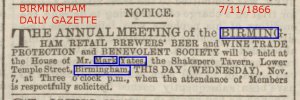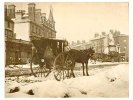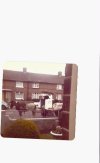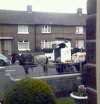This was on the thread in the group called 'Shakespeare tavern -Lower Temple Street' and give more infoHello fellow Brummies. I found this one of Shakespeare Inn. I have no further details. It was with some old photos that date around 1867, all around the Birmingham city centre. By chance there is a Shakespeare Inn near Colmore, so was wondering if this was the early version of what is there now. I Know its a slim chance with all the changes Birmingham has gone through, but any details would be appreciated THANK YOUView attachment 185178. Apologies if you get different sizes of photo!!
-
Welcome to this forum . We are a worldwide group with a common interest in Birmingham and its history. While here, please follow a few simple rules. We ask that you respect other members, thank those who have helped you and please keep your contributions on-topic with the thread.
We do hope you enjoy your visit. BHF Admin Team
You are using an out of date browser. It may not display this or other websites correctly.
You should upgrade or use an alternative browser.
You should upgrade or use an alternative browser.
Old street pics..
- Thread starter Astoness
- Start date
DavidGrain
master brummie
I was surprised to see Ind Coope on a Birmingham pub so I did a bit of research and find that they had a number of pubs in Birmingham and they list the Shakespeare Inn, Great Colmore Street as owned in 1901. Are we sure that this photo is of the Lower Temple Street pub?
brummy-lad
master brummie
Hi Mike, is there any way of confirming that it was actually called Shakspeare Inn (without the E) or was it a signwriting mistake?Mark Yates is listed as a beer retailer at 2 Lower Temple St in the 1867 Kellys
I have another copy of the photo with watermark which states date c 1879
brummy-lad
master brummie
Just found this on the 1861 census which ties in nicely with No. 2Mark Yates is listed as a beer retailer at 2 Lower Temple St in the 1867 Kellys
I have another copy of the photo with watermark which states date c 1879
Attachments
brummy-lad
master brummie
clarkstreet
proper brummie kid
Played on that in the 60s.old derilict site.was told it was a hospital for infectious diseases?Hi David
Do you have any knowledge of an island just off the Hagley Road, in the middle of the junction of two roads opposite the Ivy Bush?
My father claimed that his father was the first taxi driver in Birmingham and that his ‘pitch’ was opposite the Ivy Bush. I found an old map that shows an area marked out for a cab stand in that position - no doubt for a horsedrawn cab. The story my father told was that his father parked his motor cab there but one day the council asked him to move because they needed to build a traffic island. He refused, saying he was there first, and they agreed a compromise. He parked at one end of the area while the council built half an island at the other end with a gap through it wide enough for a taxi. When that was completed, he moved his taxi in to it and the council built the other half behind him, again with a gap for his taxi. He continued to use this space as a cab stand for some years after but I don't know when it was demolished. I have searched for photographs of this island without any luck and the taxi archive records went up in smoke some years ago. I'm hoping someone has information about it.
Kathsutton46
knowlegable brummie
Maison Celeste was a hairdressers G., my friends sister worked there in the fifties
This chuch has now been sold and has been demolished, sad really. I was Christened there in 1953, became a Church Member during the 1960s and also married there 1979.I always knew the later building as Yardley Green Methodist chapel and attended Sunday School there in the late 50’s. I don’t know what date the replacement was built but I recollect there were 2 foundation stones, laid each side of the doorway, as can just about be seen in photo. We used to go down the side passage on the right of the building to another building at the back for Sunday School.
I always knew the later building as Yardley Green Methodist chapel and attended Sunday School there in the late 50’s. I don’t know what date the replacement was built but I recollect there were 2 foundation stones, laid each side of the doorway, as can just about be seen in photo. We used to go down the side passage on the right of the building to another building at the back for Sunday School.
No. I think that’s Lees st with Devonshire st. Go up the hill and turn right, that’s Kent st north, there was a pub at the corner called the Alex I think. I lived on Kent St, 4 backa 16. From 67 -73. We used this hill for our bogeys and other hand made wheeled devices in the 60s and 70s. Great fun, lots of scrapes. We didn’t use that shop much if at all because there were 2 shops, one sweet and one grocery on Kent St. Amazing to think you couldn’t go more that 200yds without encountering a shop. Or pub!Not a particularly good one, of junction Kent St North and Devonshire St
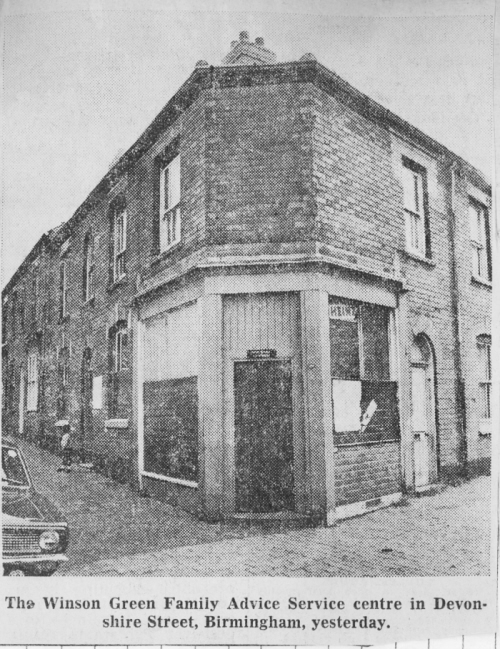
Toni62
master brummie
I was born on Great Russell St 1962right here we go folks.
lee bank road dated 1953
View attachment 117383
gt russell st dated 1965
View attachment 117384
Radiorails
master brummie
It appears to be a Hansom cab and yes, it is fodder for the horse. I believe that taxis, until fairly recent times, were supposed to carry straw in the boot as the original law had not yet been rescinded.
Lloyd
master brummie
The 1831 London Hackney Carriage Act made it an offence for drivers to feed their horse unless it was from a bag of corn or with hay from their hands. The law was repealed in 1976.It appears to be a Hansom cab and yes, it is fodder for the horse. I believe that taxis, until fairly recent times, were supposed to carry straw in the boot as the original law had not yet been rescinded.
Country Road
master brummie
Fabulous picture thank you, growing up I lived on Elvetham road, with Bell Barn road just at the bottom, so not far from Five Ways, I remember passing a large and long shop, with big windows, I think sold coats possible clothes, why it stands out is they had a huge bear in the window, definitely museum quality, I was often was found at the museum, or the old library, I was just fascinated with that bear, it still sticks in my mind. Still at school, St Thomas's, no Idea the name off the shop, but it did look upmarket. Happy days.five ways edgbaston 1909...looks like a large bag of something on the back i was wondering if it could have been hay for the horse especially as there is snow on the ground
lyn
View attachment 195830
Richard Dye
master brummie
That is a great picture!five ways edgbaston 1909...looks like a large bag of something on the back i was wondering if it could have been hay for the horse especially as there is snow on the ground
lyn
View attachment 195830
Country Road
master brummie
Hi in 1824, William Wilberforce and other men in high places, with Arther Broom a London vicar, sat at "The old Slaughter coffee house" to discuss what they could do about cruelty to animals, in particular horses who they saw being beaten daily and worked to death. They formed a society called SPCA, to protect animals against cruelty the first in the world, who thought about the welfare and care of animals. I think they have lost that calling today.How hard life was then. Hard on horses. I think they worked till they dropped for many. People too. I wonder when work houses ceased to be.
I Am Nico
master brummie
I posted before somewhere but Nan remembers a horse collapsing and dieing in the street. It stayed with her. she was a little girl and cried all the way home. If she saw a white horse she would spit on her foot for luck as they were a rare site. She remembers the pony having a good job he pulled the mower for the greens the rest of the time was left to graze.Coventry gran said if the hill was steep in the chart you had to get out and walk. They told me they put nails or segs in the horse shoes so they could grip as they often had to walk on ice pulling carriages. They remember them slithering. also putting straw down for them to get a grip.Hi in 1824, William Wilberforce and other men in high places, with Arther Broom a London vicar, sat at "The old Slaughter coffee house" to discuss what they could do about cruelty to animals, in particular horses who they saw being beaten daily and worked to death. They formed a society called SPCA, to protect animals against cruelty the first in the world, who thought about the welfare and care of animals. I think they have lost that calling today.
Eric Gibson
master brummie
I remember a Co-op milk round horse dropping dead in Sidcup Road Kingstanding and watching the recovery man dragging/sliding it up on to a trailer with a winch.
Country Road
master brummie
I feel for your nan, for a child to see the death of a horse must have been harrowing for her, as she never forgot it, when I was growing up I saw my fair share of animal cruelty, that stays with you, and today we have a rise in cruelty to all animals, a lot is lack of education on how to treat animals, and others have them for the wrong reasons. As an animal lover all my life it's upsetting that a slap on the wrist is about all people get who are cruel to animals, like many things today no deterents doesn't help animal cruelty.I posted before somewhere but Nan remembers a horse collapsing and dieing in the street. It stayed with her. she was a little girl and cried all the way home. If she saw a white horse she would spit on her foot for luck as they were a rare site. She remembers the pony having a good job he pulled the mower for the greens the rest of the time was left to graze.Coventry gran said if the hill was steep in the chart you had to get out and walk. They told me they put nails or segs in the horse shoes so they could grip as they often had to walk on ice pulling carriages. They remember them slithering. also putting straw down for them to get a grip.
Country Road
master brummie
Poor horse, poor milkman he might have had a close bond with his horse.I remember a Co-op milk round horse dropping dead in Sidcup Road Kingstanding and watching the recovery man dragging/sliding it up on to a trailer with a winch.
Thanks for sharing.
paul stacey
master brummie
Must have been quite traumatic!! for a child !! Eric .
Eric Gibson
master brummie
I think I was in my teens Paul and more interested than traumatised.
I Am Nico
master brummie
I have a photo I will try and post later, how old is old? This would be probably 1973 in Dublin, my friend's granny with who I used to stay had the vegetables delivered. They were expensive but she felt sorry for the vegetable man! She would buy 2 stone of potatoes he put them in her bucket. His name was Dougie, I thought that was the horse's name! Dougie was dour. The horse moved up house by house without being told. He was a piebald. Or Dougie would whistle. I sent the photo to an old. neighbour of theirs and she was pleased to see it. She told me it was an old milk float turned in to a vegetable cart.


